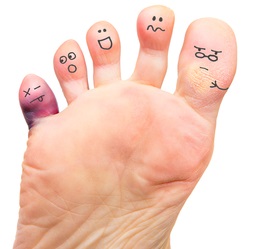Diabetic Foot Care
Foot Conditions
Recent studies show that 30.3 million Americans, 9.4 percent of the U.S. population, have diabetes. Diabetes is a disease that affects the body in many ways. Diabetes-related complications may initially be noticed in our feet where problems arise due to poor circulation, decreased sensation due to nerve damage, and slower healing ability for infections or open sores. Fortunately, patients can take positive steps to prevent many types of foot complications that arise from diabetes. The board-certified physicians at American Foot and Leg Specialists recommend diabetic patients follow a regular routine of diabetic foot care by inspecting their feet daily, and scheduling periodic office visits to have their feet checked professionally and their toenails cut to identify the symptoms of this manageable disease as early as possible.
Early consultation and treatment is an important medical decision for the diabetic patient. Treatment may entail conservative measures, such as debridement of toenails, corns and calluses, prescribing custom-made shoes, prescribing medications, care of open sores, and proper education about foot care. In some instances surgical measures are employed to ensure that foot deformities do not progressively worsen and lead to further complications.
The list of conditions below are potentially serious and require prompt and proper care to ensure you maintain the highest level of mobility and well-being. Please contact us right away if you think you may be suffering from any of the following conditions:
Ulcers (non-healing wounds): Due to poor circulation and other issues, diabetics are at increased risk for foot ulcers. Ulcers are less likely to heal for diabetics due to a higher risk of infection. Proper treatment often requires care by a podiatrist with wound care expertise. The physicians at American Foot & Leg Specialists are certified wound care specialists ready to help. learn more +
Diabetic Neuropathic Ulcerations (nerve damage): The combination of reduced feeling in the feet, possible compromised vascular supply, and friction can result in ulcerations of the feet. These can be treated conservatively or surgically by reconstruction to offload the problem areas that could cause limb threatening ulcers. Symptoms may include burning, numbness or tingling in the feet or toes. learn more +
Charcot Neuroarthropathy: One of the most devastating manifestations of neuropathy and diabetes mellitus. The condition is commonly associated with joint destruction, subluxation/dislocation, and instability. Reconstruction is often necessary to obtain the desired goal of a stable, plantigrade, braceable foot. Charcot reconstruction may be performed with internal fixation but in severe cases, external fixation may be required. learn more +
Peripheral Arterial Disease (PAD): Poor circulation in the legs which may lead to cramping, fatigue and rest pain, and increased risk of amputation. learn more +
Skin Conditions: Dry skin causes cracks, skin discoloration, itching, and irritation. Open sores cause pressure ulcers that can get infected or be difficult to heal. learn more +
Foot Deformities: Diabetic patients with bunions, hammer toes, heel spurs, ingrown toenails and other foot deformities, are at greater risk of developing complications that can lead to deformity or amputation. learn more +

Preventive Diabetic Foot Care
When it comes to diabetic foot health, prevention is the best cure. Based on experience, we know that patients who get regular checkups and take sensible daily precautions are able to prevent most diabetic foot problems from ever arising. Please let us work with you to maximize your mobility and well-being through a preventative care program. Here are some preventative care measures we recommend:
- Wash your feet daily in lukewarm water and followed by careful drying, especially between the toes.
- Avoiding moisturizers between the toes.
- Always wear proper, well fitting footwear and never walk barefoot.
- See your podiatrist for shoe gear recommendations each year.
- Be attentive to any injury to make sure it heals quickly. Even minor cuts and bruises can lead to bigger problems. If a wound does not seem to be healing right, please contact your physician immediately.
- Maintain proper overall health (no smoking, limit alcohol consumption, monitor weight, exercise regularly).
- Avoid incidental cuts and injuries by having a professional to cut your toenails and treat your callouses and corns. Depending on your situation, your health insurance may cover these regular visits.
Treatment for Diabetic Foot Problems
Whether you are suffering from ball of the foot pain or a common injury like a sprained ankle, our board-certified physicians focus on the goal of helping you maintain healthy feet and ankles. American Foot & Leg Specialists strive to prevent, detect, and treat all foot and ankle problems. Our physicians specialize in the treatment of all common foot, ankle, and leg ailments.
schedule a consultation today!
American Foot and Leg Specialists draws patients from all over the Atlanta area. Our 4 locations in Stockbridge, Forest Park, Fayetteville, and Locust Grove, are just short drive from Midtown, Buckhead, East Point, College Park, Riverdale, Jonesboro, Irondale, McDonough, and Peachtree City. Schedule a consultation today to eliminate your foot and ankle problems.

